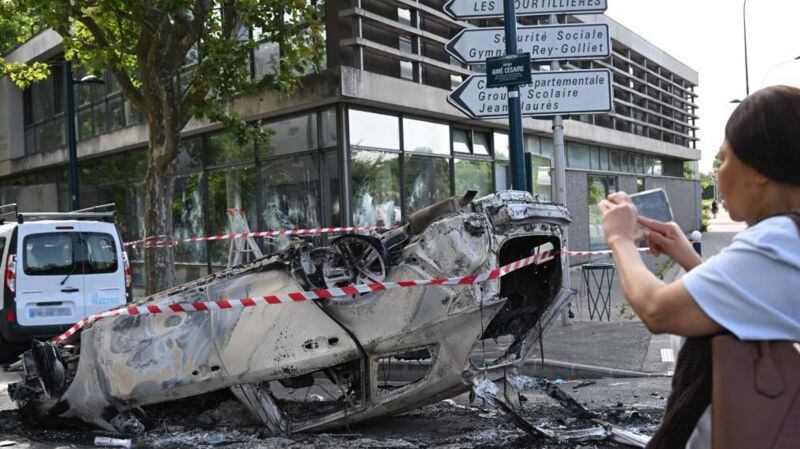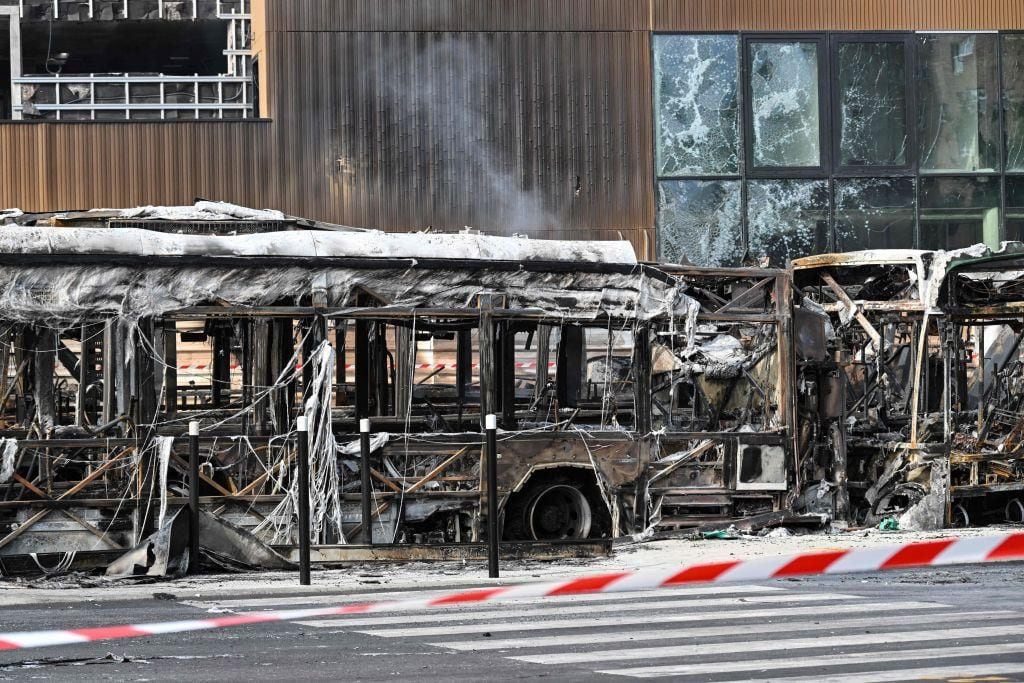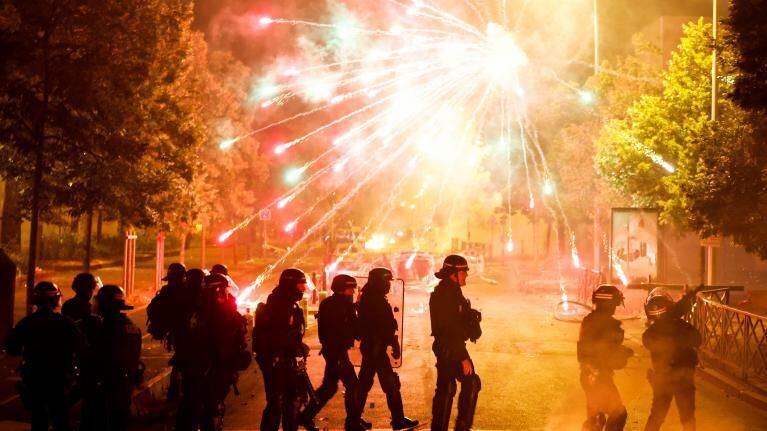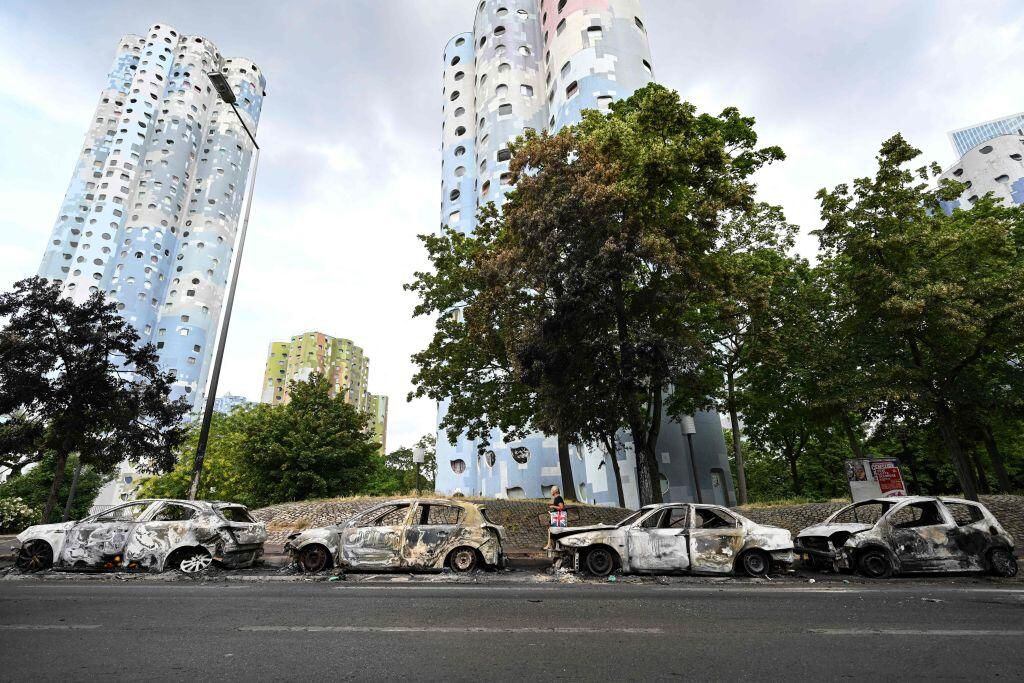The massive mobilization of police, gendarmes and elite units could not stop a fifth consecutive night of violence throughout France after the death of Nahel M., shot down by a police officer in Nanterre, a western suburb of Paris.
Protests were most violent on Saturday night in the city of Marseille, where video footage shows police using tear gas to control protesters.
LOOK: Who was Nahel M, the 17-year-old whose death by a police shot sparked a wave of protests in France
A heavy police presence in Paris made the riots there less intense.
Interior Minister Gérald Darmanin tweeted that there were 427 arrests on Saturday night and congratulated security forces for “their determined actions leading to a calmer night.”
There were more than 1,300 arrests on Friday night, and more than 900 on Thursday night.
Meanwhile, calls for calm from the authorities and public figures such as soccer player Kylian Mbappé do not seem to have any effect.
Nahel, a 17 year old teenagerdied Tuesday after a police officer shot him in the chest.
According to the first indications of the investigation, two policemen on motorcycles wanted to control the car that Nahel was driving and that was driving at high speed “on a bus lane” in the Parisian suburb.
The policemen would have told the driver to stop at a red light, but he started again.
The officer accused of shooting him has been arrested on murder charges, but the protests in France are not stopping.
Below we explain in three keys the reasons that unleashed the series of riots that are shaking France.
1. Who was Nahel and how did he die?
Nahel was a young man of Algerian origin, an only child who was raised by his mother in the Vieux-Pont district of Nanterre, according to the local newspaper Le Parisien.
The young man had been enrolled since 2021 at the Louis Blériot high school in the town of Suresnes, another peripheral city, where he hoped to obtain a certificate of professional aptitude as electrician.
Meanwhile, Nahel made a living as a pizza delivery man.
He was a “neighborhood boy” who “wanted to fit in socially and professionally, (he was not) a child who lived off drug trafficking or crime,” Jeff Puech, president of a club where the young man told Le Parisien he played rugby.
According to his lawyers, Nahel was also “very loved” in his neighborhood.
For her part, her mother described him as her “everything.”
“It was my life, it was my best friendhe was my son, he was everything to me”, said Mounia M. in front of the cameras of the national television station BFMTV.
Nahel’s lawyers insist the teen’s criminal record was clean. Which is not to say that he has never had run-ins with the police.
A few hours after his death, the Nanterre prosecutor’s office said in a statement that the teenager was “known by the justice services, in particular by refuse to obey”.

According to the account of the policeman who fired, Nahel would have died precisely after disobeying the order to stop.
The incident happened Tuesday morning near the Nanterre-Préfecture suburban train station, west of Paris.
At first, police sources assured that a vehicle had rammed into two agents on motorcycles.
But a video circulating on social networks, authenticated by the AFP agency, shows that one of the two police officers pointed at the driver and then shot point blank when the car started.

In the video, someone can be heard saying “they are going to shoot you in the head”, but that phrase has not been attributed to anyone in particular. Nahel died shortly after being shot in the chest.
The 38-year-old police officer suspected of the fatal shooting was detained as part of the investigation.
2. “Racism” and police brutality
Nahel’s case has reignited controversy over police action in France, where a record 13 deaths were recorded during traffic checkpoints last year.
Nahel is the second person this year to die this way in France.
Two weeks ago, a 19-year-old driver was shot by police in a town in western France after he allegedly hit an officer in the legs during a traffic check.
Organizations such as Amnesty International and the Council of Europe have recently accused the French security forces of police abuse in handling massive demonstrations, such as those of the “yellow vests” or the most recent protests against the pension reform.
But Nahel’s death seems to show that the problem goes further.
Three days after his death, the UN asked France this Friday to seriously address the racism issues and racial discrimination within their police forces.

“Now is the time for the country to seriously address the deep-seated problems of racism and racial discrimination among law enforcement,” Ravina Shamdasani, spokesperson for the United Nations High Commissioner for Human Rights, said during the regular press conference in the UN in Geneva, Switzerland.
Shamdasani also called on the French authorities to ensure that the use of force by the police to confront violent elements during demonstrations respect the principles of legalitynecessity, proportionality, non-discrimination.

3. The problem of the suburbs
Nahel’s death has reawakened the suburban rage disadvantaged in France, those peripheral cities that are often home to the poorest sections of French society.
“People living in these communities are twice as likely to be immigrants as the national average and three times as likely to be unemployed,” Iona Lefebvre wrote in her article for the Montaigne Institute.
These neighborhoods, known as banlieues (the periphery of the cities), become scenes of violent protests after cases such as that of Nahel, which occur with some frequency.
In 2005 it was the Parisian suburb of Clichy-sous-Bois that exploded, after the death of two young Muslims aged 15 and 17, electrocuted in an electrical substation while escaping from the police.
Nicolas Sarkozy, then interior minister and later French president, called the protesters who started the protests “scum.”
The banlieu was reawakened in 2017, after the young Théodore Luhaka was violently mistreated by the police in another Paris suburb, Seine-Saint-Denis.

Now it is Nanterre’s turn after Nahel’s death.
The French sociologist Fabien Truong, professor at the University of Paris-VIII, explained in an interview with the newspaper Le Monde that many of the protesters are boys of the same age as this teenager, who react “intimately and violently“for the simple reason that the victim could have been one of them.
“All adolescents in these neighborhoods have memories of negative and violent altercations with the police,” said the academic and concluded:
“In these neighborhoods, poverty and insecurity are concrete realities. That is why this anger is political.”
Norberto Paredes
BBC News World
Source: Elcomercio
I am Jack Morton and I work in 24 News Recorder. I mostly cover world news and I have also authored 24 news recorder. I find this work highly interesting and it allows me to keep up with current events happening around the world.

:quality(75)/cloudfront-us-east-1.images.arcpublishing.com/elcomercio/YSJH6T4JABH63BZWVO24QQN7GU.jpg)





